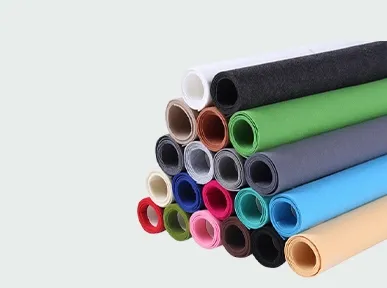felt material
The Versatility of Felt Material An Exploration
Felt, a textile that dates back thousands of years, has a rich and varied history rooted in its versatility and utility. Originating as a practical fabric for clothing and shelter, felt has evolved into a beloved material for crafts, fashion, and home decor. This article will explore the characteristics, production methods, and endless applications of felt material.
What is Felt?
At its core, felt is created by matting, condensing, and pressing fibers together, resulting in a dense and durable fabric. Unlike woven or knitted textiles, felt is produced without the use of a loom; instead, it relies on the natural properties of fibers. The most common materials used in felt production include wool, but synthetic fibers like polyester and acrylic are also popular. Each fiber type brings its own characteristics to the final product, influencing its texture, durability, and appearance.
Characteristics of Felt
One of the most distinctive features of felt is its ability to be shaped and molded. Wool felt, for example, is naturally pliable and can be easily cut, sewn, and embroidered without fraying at the edges. This makes it an ideal choice for a variety of crafting applications, from DIY projects to commercial manufacturing. Additionally, felt is often praised for its insulating properties, which make it a great choice for soundproofing and thermal insulation in buildings.
Moreover, felt is inherently sturdy and resilient. It resists wear and tear, making it suitable for both long-lasting products and items that undergo significant handling. Felt can also be dyed in a wide range of colors, allowing for creative expression in design and crafts. Its unique, soft texture adds a tactile dimension to both the aesthetic and functional applications of felt.
Production of Felt
The production of felt can be broken down into a few primary methods wet felting and needle felting. Wet felting, the more traditional method, involves the use of water and soap to cause the fibers to mat together. This process relies on agitation and friction, which interlocks the fibers. On the other hand, needle felting employs barbed needles to entangle the wool fibers without the need for moisture, enabling the creation of intricate designs and three-dimensional shapes.
felt material

In recent years, technological advancements have made it possible to create industrial-grade felt using automated processes, where synthetic fibers are blended with natural ones. This transition has expanded the applications of felt, leading to its use in various sectors, from automotive to fashion.
Applications of Felt
Felt is remarkably versatile and finds its way into countless applications across various domains. In the world of crafts, felt is a favorite among hobbyists and professionals alike. It can be transformed into everything from decorative items, like wall hangings and mobile art, to functional creations, such as bags and wallets.
In fashion, felt has made a comeback as a trendy material for hats, coats, and accessories. Its unique properties not only lend themselves to stylish designs but also offer practicality—keeping wearers warm while providing durability.
Felt's applications extend beyond personal use; it is widely used in the industry as well. For instance, it serves as an ideal material for soundproofing studios and appliances due to its excellent acoustic properties. In the automotive world, felt linings are used to reduce noise and vibration, contributing to a quieter ride.
Moreover, felt has gained popularity in educational and therapeutic settings. It is often used in early childhood education for interactive learning tools, such as felt boards that enhance storytelling and creative play. Eco-friendly and safe for children, felt is also utilized in sensory toys and therapeutic tools for individuals with special needs, providing both tactile stimulation and comfort.
Conclusion
Felt material is truly a multifaceted fabric that bridges tradition and modernity. Its rich history, combined with its diverse applications and sustainable potential, makes it an essential material in our everyday lives. Whether it’s in the form of an intricate craft project, a fashionable accessory, or a crucial industrial component, felt continues to inspire creativity and innovation across the globe. As we move forward, its role in sustainable practices and design will undoubtedly grow, further solidifying its place in our material culture.
-
What Makes Felt a Great Choice?NewsNov.19,2024
-
Total Mixed Ration (TMR) Feed for CattleNewsNov.19,2024
-
The Ultimate Guide for Felt Polishing WheelsNewsNov.19,2024
-
Industrial Felt for Various ApplicationsNewsNov.19,2024
-
Felt Makeup Bags and Inserts BagsNewsNov.19,2024
-
Choosing the Right Hotel TowelsNewsNov.19,2024
-
Your Go-To Guide For Affordable Wholesale Wool FeltsNewsOct.31,2024







